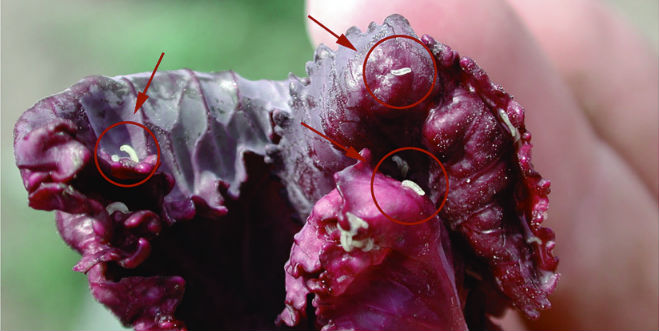

Mar 1, 2017Plan ahead to protect cole crops from swede midge
Michigan cole crops growers must be wary of a new pest, the swede midge, according to Ben Phillips, a Michigan State University Extension educator. Phillips discussed swede midge and how to manage it during the Great Lakes Fruit, Vegetable & Farm Market EXPO.
Native to Europe and southwest Asia, the invader has spread to at least seven U.S. states and six Canadian provinces since it was first identified in North America in 2000. Swede midge was first confirmed in Michigan in 2015. Producing nearly 80 million pounds of cabbage, worth more than $10 million annually, losses to swede midge could be devastating for the state. The farm where it was first discovered lost its entire crop in 2015, according to Phillips.
Invasive insects typically cause greater economic losses at the invasion front, soon after establishment and initial population growth. Growers can expect greater losses soon after establishment as opposed to later on, once biological control agents have started to work. Because the pest is new and unfamiliar and they will face greater pressure in the initial years, growers need help identifying the pest now, he said.
The swede midge adult, about 2 millimeters in length, has hairy wings and a light-brown or orange body. There are three to five generations from May to October. Host plants include broccoli, cabbage, cauliflower, Brussels sprouts, kale, collards, rutabagas, radishes, horseradish, turnips, canola, wild mustard, shepherd’s purse, stinkweed, field peppergrass and yellow rocket. Larvae feed on leaf bases and flower buds emerging from the growing tip of the plant by secreting digestive fluids that break down the waxy plant cuticle. This results in twisting, curling, crinkling and drawstring damage to leaves, and swollen leaf stems where they meet the main stalk. The cole crops most susceptible to economic damage are heading types, with broccoli and cauliflower susceptible at all stages, according to Phillips.
In the 2016 growing season, Extension staff set up a monitoring network of pheromone traps across the southern half of Michigan’s Lower Peninsula. The traps were placed at 17 conventional and organic farms, which produced cole crops throughout the entire season. Traps were checked weekly. Despite some problems with the pheromone lures, they captured a total of 59 swede midges during the season, with a spike in late July and early August. Although swede midge was first discovered on the east side of Michigan, they were spread throughout the sampling range, including at some of the southwest farms. All the organic farms and two-thirds of the conventional farms had confirmed catches, according to Phillips.
Management options
In his presentation, Phillips described a few swede midge management options in detail.


Insecticides. Swede midges can be managed in the field with several types of pyrethroid foliar sprays, soil drenches and seed treatments of neonicotinoids, although none of these methods are effective when populations are high with overlapping generations. In organic production, pyrethrin, Beauvaria bassiana, azadirachtin and spinosad offer the greatest potential for swede midge management, if applied when egg laying is ongoing. In general, foliar sprays are less effective when larval populations are established, since contact insecticides are difficult to deliver to the deformed, curled areas of the leaf where larval feeding is occurring.
Monitoring. Pheromone lures are available for monitoring swede midge males and can be used in traps to time insecticide applications in cabbage, but this threshold did not work to protect broccoli. For cabbage, an action threshold of five to 10 males per trap per day is recommended (with monitoring every two to four days). For broccoli in regions of low swede midge populations, a threshold of one male per trap per day is recommended. For broccoli in areas with high populations, using thresholds has not been more effective than weekly calendar sprays.
Biocontrol. Despite the fact that there are two species of swede midge parasitoids known from Europe, mortality due to parasitoids is not likely to occur in Michigan since it is a relatively new invader. The two European species are not considered targets for classical biological control because they are not host specific. Ladybeetles can feed on swede midge larvae, but this has only been verified in the laboratory. Other predators such as dolichopodid flies can prey on adult swede midges. Entomopathogenic nematodes can suppress adult emergence, though effects were not consistent in field trials.
Host plant resistance. Differences in host plant suitability were observed among several cultivars of cabbage, broccoli, and leafy greens, with species in the brassica genus generally more susceptible than plants in other genera.
Cultural control. Swede midges pupate in the top centimeter of soil, so more than 5 centimeters of soil cover can reduce and delay emergence of adults. In addition, extreme dry or wet soil conditions significantly hindered emergence. Crop rotation (rotating away from crucifers for one to two years) is a successful way to control swede midges, but the effectiveness can be diminished by the presence of cruciferous weeds. Mesh barriers can prevent swede midge colonization of fields where crucifers have not been grown previously. In general, early planted crops experience less damage from swede midge than late-planted crops, so manipulating the planting date can be another way to reduce damage, according to Phillips.















